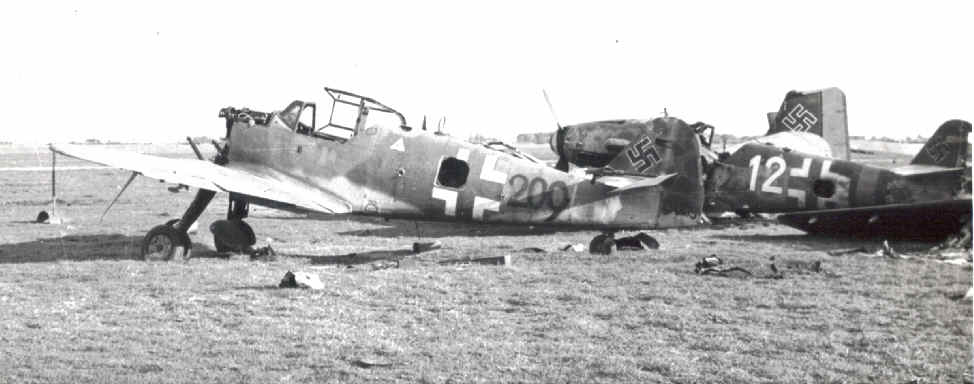
Image du Jours -- World War II
About this Hangar Scene -- WWII #13 of 23.

(Image from Stockum-Cashion Collection)
This is the last photo of this "clump" of aircraft sitting in front of the last hangar.
Enough has been said about the "12" and the unidentifiable JU-87 behind it, and in this photo, the only new information is seeing the rest of an engineless "209", an Me-109G10.
It is interesting that the canopy is still on but the engine off and the radio is most likely removed, though the circular radio direction finder antenna is still on whereas it has been removed from "12" -- or "12" never had one.
Cannons in front of the canopy have the breeches and ammo feeder chute, but the barrels have been unscrewed, no doubt to gain access to some of the engine fire wall components. It was common practice to remove the engine mount structure with the engine. Almost all ground test fixtures mated to the engine mount rather than to the engine proper. The struts seen going from the fire wall out into the air are for the shock dampers on each side of the engine.
The triangle at upper fuselage points to the fuel filler pipe and indicates fuel type -- by spring of 1945, it might have read "anything that burns." The oval-like marking on the fuselage at the edge of the canopy is a spring-loaded handhold, and the half-circle outline at wing root faring marks where the spring-loaded foot step is.
The rudder has a static balance projecting into the fin about 12" down from fin tip. This was also helpful for aerodynamic trimming. And there is a little tear-drop shape on a small strut hanging from the left aileron, this was for static balance but it also helped eliminate aileron flutter by increasing the over-all dynamic mass of the control surface.
I do not know what the neat round hole is down from aft corner of fueling mark. Judging from the station and stringer, there is nothing internal aligned there that I know of.
Just behind the pilot’s seat would have been armor plating and then the fuel tank, also with them were the oxygen bottles. These bottles were serviced through hatches on the right side, or through the radio hatch.
Providing electrical power for the radio equipment was a dynamotor mounted to the end of the radio tray. These were arc proof for safety; that is, they were when they were manufactured. By the last year of the war, this equipment had been vibrated many hours and gone through all sorts of temperature cycling and the insulation would be breaking down, so it can be assumed that they were no longer as arc-free as the pilots would have wanted.
So what is in that area is a fuel tank and oxygen bottles and both can be punctured by a bullet...leaving the fuel to dribble down on the dynamotor. Once the fuel ignited with all the spraying oxygen....
Accurate determinations of various positions in the fuselage can be determined by counting the stations -- the lines of rivets that go around the fuselage. They secure the skin panels to former. The stringers are harder to track because a lot of times there is no skin edge, but in this case it is obvious that the small round hole is no more than an inch above the stringer that defines the lower radio hatch lip. The forward edge of the hole is the same distance from the fuselage former that runs up to the fuel fill pipe. This information is valuable when comparing different sub-variants and cut-away drawings and the like.
It cannot be determined what any of the scattered pieces on the ground are -- some of it could have been blown there from "12"s explosion.
In the next couple of Image du Jours, we will look at an interesting Fw-190.
Ken Cashion